Evaluation of Chloride Ion Attack in Self-Compacting Concrete Using Recycled Construction and Demolition Waste Aggregates
Abstract
:1. Introduction
2. Materials and Methods
2.1. Materials
2.2. Mixture Proportions
2.3. Mix Preparation and Sample Molding
- -
- (1st) Add 100% coarse aggregate and 30% water, and mix for 30 s;
- -
- (2nd) Add 50% sand and 20% water, and mix for 30 s;
- -
- (3rd) Add 100% cement, 50% sand, and 40% water, and mix for 2 min;
- -
- (4th) Add 50% admixture and mix for 2 min;
- -
- (5th) Add 100% metakaolin, 10% water, and 50% admixture, and mix for 3 min.
2.4. Properties of Fresh SCC
2.5. Properties of SCC in the Hardened State
2.5.1. Compressive Strength
2.5.2. Ultrasonic Pulse Velocity (UPV)
2.5.3. Chloride Penetration under Wetting and Drying Cycles
2.5.4. Chloride Ion Diffusion
2.5.5. Electrical Resistivity
2.5.6. Water Absorption and Void Index
3. Results and Discussion
3.1. Fresh Properties of SCC
3.2. Properties of SCC in Hardened State
3.2.1. Axial Compressive Strength
3.2.2. Ultrasound Pulse Velocity (UPV)
3.2.3. Chloride Penetration by Wetting and Drying Cycle, Chloride Ion Diffusion, and Electrical Resistivity
3.2.4. Water Absorption and Void Index
4. Conclusions
- SCC mixtures with incorporated recycled CDW aggregates demonstrated self-compacting properties, with no signs of segregation or bleeding. It was necessary to add the absorption water of the recycled aggregates and slightly increase the superplasticizer content.
- The use of recycled aggregates in SCC led to a compressive strength reduction. However, the addition of 10% metakaolin (MK) compensated for the strength loss, and the SCC mixture with recycled sand and metakaolin (RS_NG (MK)) achieved a compressive strength similar to that of the reference mixture (55.10 MPa). There was no significant difference in the compressive strengths of the SCC mixtures after the aggressive chloride attack.
- The ultrasonic pulse velocity of the SCC mixtures decreased with the incorporation of recycled aggregates due to their high porosity. However, the SCC mixture with recycled sand and metakaolin (RS_NG (MK)) obtained values similar to those of the reference mixture. There were no significant changes in the ultrasonic pulse velocities of the SCC mixtures after the aggressive chloride attack.
- The chloride ion penetration depth in the SCC mixture with recycled aggregates (RS_RG) was quite similar to that of the reference mixture. However, the addition of MK limited the chloride’s ingress in mixtures with recycled aggregates, resulting in better results compared to the reference mixture.
- The SCC mixture with recycled aggregates had a higher chloride ion diffusion coefficient when compared to the reference mixture. The addition of MK to SCC mixtures with recycled aggregates is essential for chloride diffusion reduction.
- The electrical resistivity was slightly higher in the SCC mixture with recycled aggregates than in the SCC mixture with natural aggregates (reference) at 118 days of age. The addition of MK significantly increased the electrical resistivity of the SCC mixtures containing recycled aggregates. The electrical resistivity of the mixtures decreased after the aggressive chloride attack. SCC mixtures that incorporated recycled fine and coarse aggregates separately remained in the moderate corrosion risk range.
5. Future Research
- The behavior of SCC with recycled aggregates from construction and demolition waste exposed to accelerated and natural carbonation;
- The behavior of SCC with recycled aggregates from construction and demolition waste exposed to combined cycles of aggressive exposure, i.e., carbonation and chloride ion attack;
- Specific treatments on recycled aggregates from construction and demolition waste, such as treatment with acid solution to remove the old mortar layer, selective separation by density, and improvement of granulometry, for use in structural concrete.
Author Contributions
Funding
Data Availability Statement
Acknowledgments
Conflicts of Interest
References
- Sasanipour, H.; Aslani, F. Durability properties evaluation of self-compacting concrete prepared with waste fine and coarse recycled concrete aggregates. Constr. Build. Mater. 2020, 236, 117540. [Google Scholar] [CrossRef]
- Tam, V.W.Y.; Soomro, M.; Evangelista, A.C.J. A review of recycled aggregate in concrete applications (2000–2017). Constr. Build. Mater. 2018, 172, 272–292. [Google Scholar] [CrossRef]
- Tam, V.W.Y.; Soomro, M.; Evangelista, A.C.J. Quality improvement of recycled concrete aggregate by removal of residual mortar: A comprehensive review of approaches adopted. Constr. Build. Mater. 2021, 288, 123066. [Google Scholar] [CrossRef]
- Gonçalves, P.; Brito, J. Recycled aggregate concrete (RAC)—Comparative analysis of existing specifications. Mag. Concr. Res. 2010, 62, 339–346. [Google Scholar] [CrossRef]
- Xiao, J.; Wang, C.; Ding, T.; Akbarnezhad, A. A recycled aggregate concrete high-rise building: Structural performance and embodied carbon footprint. J. Clean. Prod. 2018, 199, 868–881. [Google Scholar] [CrossRef]
- Bravo, M.; De Brito, J.; Pontes, J.; Evangelista, L. Durability performance of concrete with recycled aggregates from construction and demolition waste plants. Constr. Build. Mater. 2015, 77, 357–369. [Google Scholar] [CrossRef]
- Shanko, Y.; Abera, A. Performance of concrete materials containing recycled aggregate from construction and demolition waste. Results Mater. 2022, 14, 100278. [Google Scholar] [CrossRef]
- Abera, S.A. Analytical study on properties of concrete materials incorporating recycled aggregates from construction and demolition waste. Mater. Today Proc. 2022, 52, 2172–2183. [Google Scholar] [CrossRef]
- Zhu, Y.; Zahedi, A.; Sanchez, L.F.M.; Fournier, B.; Beauchemin, S. Overall assessment of alkali-silica reaction affected recycled concrete aggregate mixtures derived from construction and demolition waste. Cem. Concr. Res. 2021, 142, 106350. [Google Scholar] [CrossRef]
- Sasanipour, H.; Aslani, F.; Taherinezhad, J. Effect of silica fume on durability of self-compacting concrete made with waste recycled concrete aggregates. Constr. Build. Mater. 2019, 227, 116598. [Google Scholar] [CrossRef]
- Revilla-Cuesta, V.; Ortega-López, V.; Skaf, M.; Manso, J.M. Effect of fine recycled concrete aggregate on the mechanical behavior of self-compacting concrete. Constr. Build. Mater. 2020, 263, 120671. [Google Scholar] [CrossRef]
- Guo, Z.; Jiang, T.; Zhang, J.; Kong, X.; Chen, C.; Lehman, D.E. Mechanical and durability properties of sustainable self-compacting concrete with recycled concrete aggregate and fly ash, slag and silica fume. Constr. Build. Mater. 2020, 231, 117115. [Google Scholar] [CrossRef]
- Kapoor, K.; Singh, S.P.; Singh, B. Durability of self-compacting concrete made with Recycled Concrete Aggregates and mineral admixtures. Constr. Build. Mater. 2016, 128, 67–76. [Google Scholar] [CrossRef]
- Pedro, D.; de Brito, J.; Evangelista, L. Structural concrete with simultaneous incorporation of fine and coarse recycled concrete aggregates: Mechanical, durability and long-term properties. Constr. Build. Mater. 2017, 154, 294–309. [Google Scholar] [CrossRef]
- Berredjem, L.; Arabi, N.; Molez, L. Mechanical and durability properties of concrete based on recycled coarse and fine aggregates produced from demolished concrete. Constr. Build. Mater. 2020, 246, 118421. [Google Scholar] [CrossRef]
- Biswal, U.S.; Dinakar, P. Evaluating corrosion resistance of recycled aggregate concrete integrating ground granulated blast furnace slag. Constr. Build. Mater. 2023, 370, 130676. [Google Scholar] [CrossRef]
- Liang, C.; Cai, Z.; Wu, H.; Xiao, J.; Zhang, Y.; Ma, Z. Chloride transport and induced steel corrosion in recycled aggregate concrete: A review. Constr. Build. Mater. 2021, 282, 122547. [Google Scholar] [CrossRef]
- Moghaddas, S.A.; Nekoei, M.; Golafshani, E.M.; Nehdi, M.; Arashpour, M. Modeling carbonation depth of recycled aggregate concrete using novel automatic regression technique. J. Clean. Prod. 2022, 371, 133522. [Google Scholar] [CrossRef]
- Zega, C.J.; Di Maio, Á.A.; Zerbino, R.L. Influence of Natural Coarse Aggregate Type on the Transport Properties of Recycled Concrete. J. Mater. Civ. Eng. 2014, 26, 4014006. [Google Scholar] [CrossRef]
- Pereira-De-Oliveira, L.A.; Nepomuceno, M.C.S.; Castro-Gomes, J.P.; Vila, M.F.C. Permeability properties of self-Compacting concrete with coarse recycled aggregates. Constr. Build. Mater. 2014, 51, 113–120. [Google Scholar] [CrossRef]
- Manzi, S.; Mazzotti, C.; Bignozzi, M.C. Self-compacting concrete with recycled concrete aggregate: Study of the long-term properties. Constr. Build. Mater. 2017, 157, 582–590. [Google Scholar] [CrossRef]
- Bahrami, N.; Zohrabi, M.; Mahmoudy, S.A.; Akbari, M. Optimum recycled concrete aggregate and micro-silica content in self-compacting concrete: Rheological, mechanical and microstructural properties. J. Build. Eng. 2020, 31, 101361. [Google Scholar] [CrossRef]
- Sasanipour, H.; Aslani, F. Effect of specimen shape, silica fume, and curing age on durability properties of self-compacting concrete incorporating coarse recycled concrete aggregates. Constr. Build. Mater. 2019, 228, 117054. [Google Scholar] [CrossRef]
- Singh, N.; Singh, S.P. Carbonation and electrical resistance of self compacting concrete made with recycled concrete aggregates and metakaolin. Constr. Build. Mater. 2016, 121, 400–409. [Google Scholar] [CrossRef]
- Duan, Z.; Singh, A.; Xiao, J.; Hou, S. Combined use of recycled powder and recycled coarse aggregate derived from construction and demolition waste in self-compacting concrete. Constr. Build. Mater. 2020, 254, 119323. [Google Scholar] [CrossRef]
- Hassan, K.E.; Cabrera, J.G.; Maliehe, R.S. Effect of mineral admixtures on the properties of high-performance concrete. Cem. Concr. Compos. 2000, 22, 267–271. [Google Scholar] [CrossRef]
- NBR 16697; Cimento Portland—Requisitos. Associação Brasileira de Normas Técnicas (ABNT): Rio Janeiro, Brazil, 2018.
- C-150; Standard Specification for Portland Cement. ASTM: West Conshohocken, PA, USA, 2009.
- EN-197-1; Cement—Part 1: Composition, Specifications and Conformity Criteria for Common Cements. European Committee for Standardization: Brussels, Belgium, 2011.
- NBR NM 248; Agregados—Determinação da Composição Granulométrica. Associação Brasileira de Normas Técnicas (ABNT): Rio Janeiro, Brazil, 2003; p. 6.
- NBR NM 52; Agregado Miúdo—Determinação da Massa Específica e Massa Específica Aparente. Associação Brasileira de Normas Técnicas (ABNT): Rio Janeiro, Brazil, 2003; p. 6.
- NBR NM 53; Agregado Graúdo—Determinação da Massa Específica, Massa Específica Aparente e Absorção de Água. Associação Brasileira de Normas Técnicas (ABNT): Rio Janeiro, Brazil, 2009; p. 6.
- NBR 16972; Agregados—Determinação da Massa Unitária e do Índice de Vazios. Associação Brasileira de Normas Técnicas (ABNT): Rio Janeiro, Brazil, 2021; p. 10.
- NBR NM 46; Agregados—Determinação do Material Fino que Passa Através da Peneira 75 um, Por Lavagem. Associação Brasileira de Normas Técnicas (ABNT): Rio Janeiro, Brazil, 2006; p. 6.
- EFNARC. The European Guidelines for Self-Compacting Concrete; EFNARC: Flums, Switzerland, 2005; p. 63. [Google Scholar]
- NBR 15823-2; Concreto Autoadensável—Parte 2: Determinação do Espalhamento do Tempo de Escoamento e do Índice de Estabilidade Visual—Método do Cone de Abrams. Associação Brasileira de Normas Técnicas (ABNT): Rio Janeiro, Brazil, 2017; p. 5.
- NBR 15823-3; Concreto Autoadensável—Parte 3: Determinação da Habilidade Passante—Método do Anel J. Associação Brasileira de Normas Técnicas (ABNT): Rio Janeiro, Brazil, 2017; p. 4.
- NBR 15823-4; Concreto Autoadensável—Parte 4: Determinação da Habilidade Passante—Métodos da Caixa L e da Caixa U. Associação Brasileira de Normas Técnicas (ABNT): Rio Janeiro, Brazil, 2017; p. 7.
- NBR 15823-5; Concreto Autoadensável—Parte 5: Determinação da Viscosidade—Método do Funil V. Associação Brasileira de Normas Técnicas (ABNT): Rio Janeiro, Brazil, 2017; p. 4.
- Montemor, M.F.; Cunha, M.P.; Ferreira, M.G.; Simões, A.M. Corrosion behaviour of rebars in fly ash mortar exposed to carbon dioxide and chlorides. Cem. Concr. Compos. 2002, 24, 45–53. [Google Scholar] [CrossRef]
- NBR 5739; Concreto—Ensaios de Compressão de Corpos de Prova Cilíndricos. Associação Brasileira de Normas Técnicas (ABNT): Rio Janeiro, Brazil, 2007; p. 9.
- NBR 8802; Concreto Endurecido—Determinação da Velocidade de Propagação de Onda Ultrassônica. Associação Brasileira de Normas Técnicas (ABNT): Rio Janeiro, Brazil, 2013; p. 8.
- NT BUILD 492; Concrete, Mortar and Cement-Based Repair Materials: Chloride Migration Coefficient from Non-Steady-State Migration Experiments. Nordtest Method: Espoo, Finland, 1999; p. 8.
- E-463; Concreto—Determinação do Coeficiente de Difusão dos Cloretos por Migração em Regime não Estacionário. LNEC: Lisboa, Portugal, 2004; p. 8.
- G57; Standard Test Method for Field Measurement Resistivity Using the Wenner Four-Electrode Method. American Society for Testing and Materials (ASTM): Conshohocken, PA, USA, 2012.
- Vennesland, Ø.; Raupach, M.; Andrade, C. Recommendation of Rilem TC 154-EMC: “Electrochemical techniques for measuring corrosion in concrete”—Measurements with embedded probes. Mater. Struct. 2007, 40, 745–758. [Google Scholar] [CrossRef]
- NBR 9778; Argamassa e Concreto Endurecidos—Determinação da Absorção de Água, Índice de Vazios e Massa Específica. Associação Brasileira de Normas Técnicas (ABNT): Rio Janeiro, Brazil, 2009.
- Salesa, Á.; Pérez-Benedicto, J.Á.; Esteban, L.M.; Vicente-Vas, R.; Orna-Carmona, M. Physico-mechanical properties of multi-recycled self-compacting concrete prepared with precast concrete rejects. Constr. Build. Mater. 2017, 153, 364–373. [Google Scholar] [CrossRef]
- Kapoor, K.; Singh, S.P.; Singh, B.; Singh, P. Effect of recycled aggregates on fresh and hardened properties of self compacting concrete. Mater. Today Proc. 2020, 32, 600–607. [Google Scholar] [CrossRef]
- Hassan, A.A.A.; Lachemi, M.; Hossain, K.M.A. Effect of metakaolin and silica fume on the durability of self-consolidating concrete. Cem. Concr. Compos. 2012, 34, 801–807. [Google Scholar] [CrossRef]
- Gbozee, M.; Zheng, K.; He, F.; Zeng, X. The influence of aluminum from metakaolin on chemical binding of chloride ions in hydrated cement pastes. Appl. Clay Sci. 2018, 158, 186–194. [Google Scholar] [CrossRef]
- Pillay, D.L.; Olalusi, O.B.; Awoyera, P.O.; Rondon, C.; Echeverría, A.M.; Kolawole, J.T. A Review of the Engineering Properties of Metakaolin Based Concrete: Towards Combatting Chloride Attack in Coastal/Marine Structures. Adv. Civ. Eng. 2020, 2020, 8880974. [Google Scholar] [CrossRef]
- Figueiredo, C.P.; Santos, F.B.; Cascudo, O.; Carasek, H.; Cachim, P.; Velosa, A. The role of metakaolin in the protection of concrete against the deleterious action of chlorides. Rev. IBRACON Estrut. Mater. 2014, 7, 685–708. [Google Scholar] [CrossRef]
- Mahmood, W.; Khan, A.R.; Ayub, T. Mechanical and Durability Properties of Concrete Containing Recycled Concrete Aggregates. Iran. J. Sci. Technol.-Trans. Civ. Eng. 2022, 46, 2111–2130. [Google Scholar] [CrossRef]
- Medeiros-Junior, R.A.; Gans, P.S.; Pereira, E.; Pereira, E. Electrical resistivity of concrete exposed to chlorides and sulfates. ACI Mater. J. 2019, 116, 119–130. [Google Scholar] [CrossRef]
- Maes, M.; De Belie, N. Resistance of concrete and mortar against combined attack of chloride and sodium sulphate. Cem. Concr. Compos. 2014, 53, 59–72. [Google Scholar] [CrossRef]
- Talero, R.; Trusilewicz, L.; Delgado, A.; Pedrajas, C.; Lannegrand, R.; Rahhal, V.; Mejía, R.; Delvasto, S.; Ramírez, F.A. Comparative and semi-quantitative XRD analysis of Friedel’s salt originating from pozzolan and Portland cement. Constr. Build. Mater. 2011, 25, 2370–2380. [Google Scholar] [CrossRef]
- Borg, R.P.; Cuenca, E.; Garofalo, R.; Schillani, F.; Nasner, M.L.; Ferrara, L. Performance Assessment of Ultra-High Durability Concrete Produced from Recycled Ultra-High Durability Concrete. Front. Built Environ. 2021, 7, 648220. [Google Scholar] [CrossRef]
- Evangelista, L.; De Brito, J. Durability of crushed fine recycled aggregate concrete assessed by permeability-related properties. Mag. Concr. Res. 2019, 71, 1142–1150. [Google Scholar] [CrossRef]
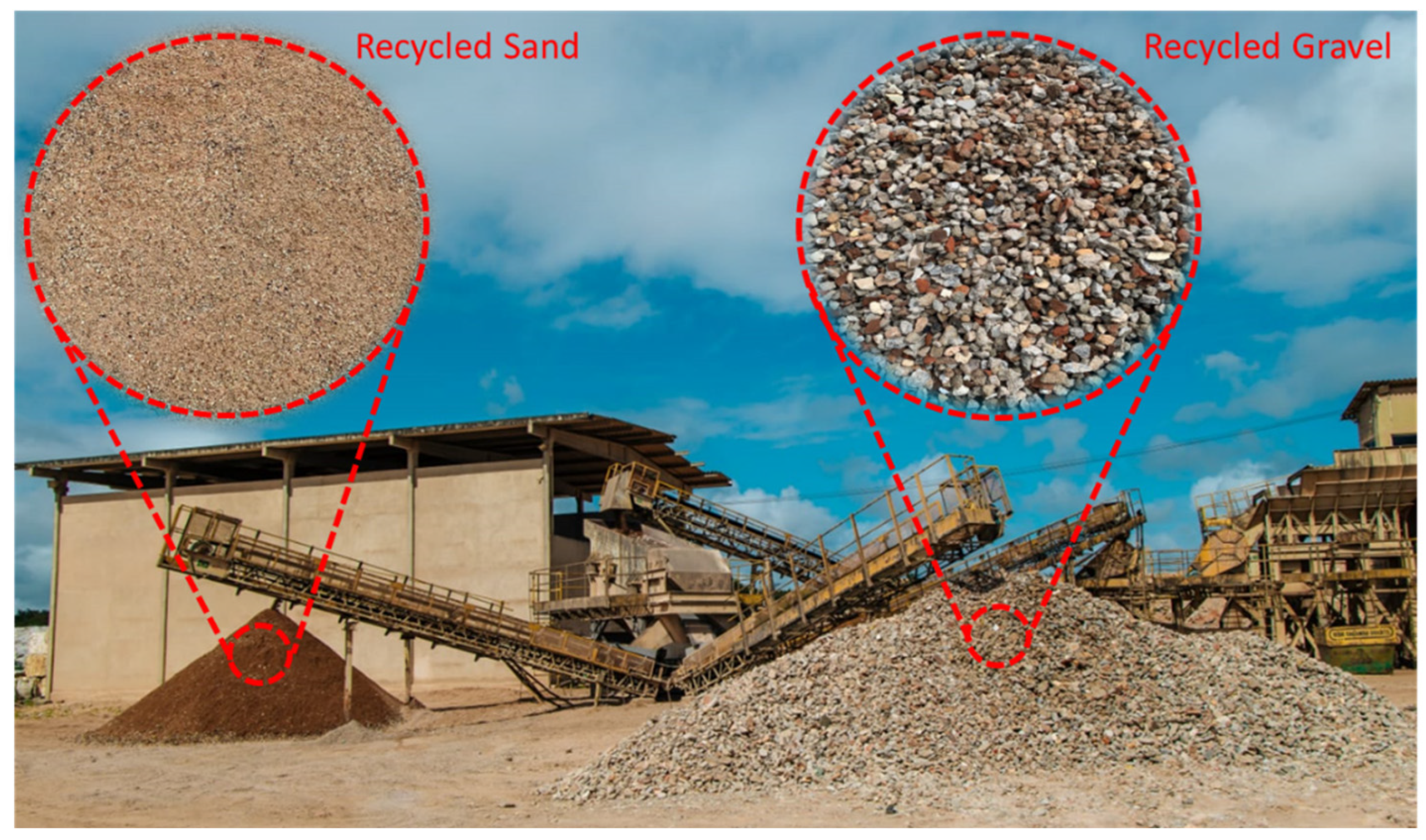
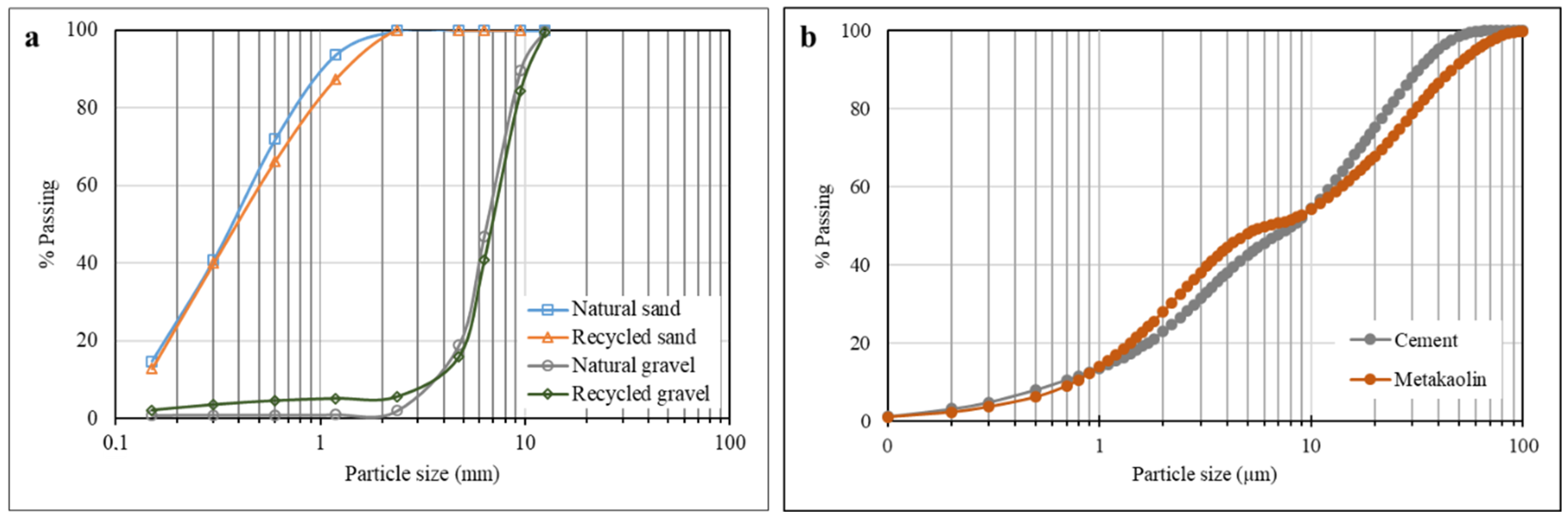
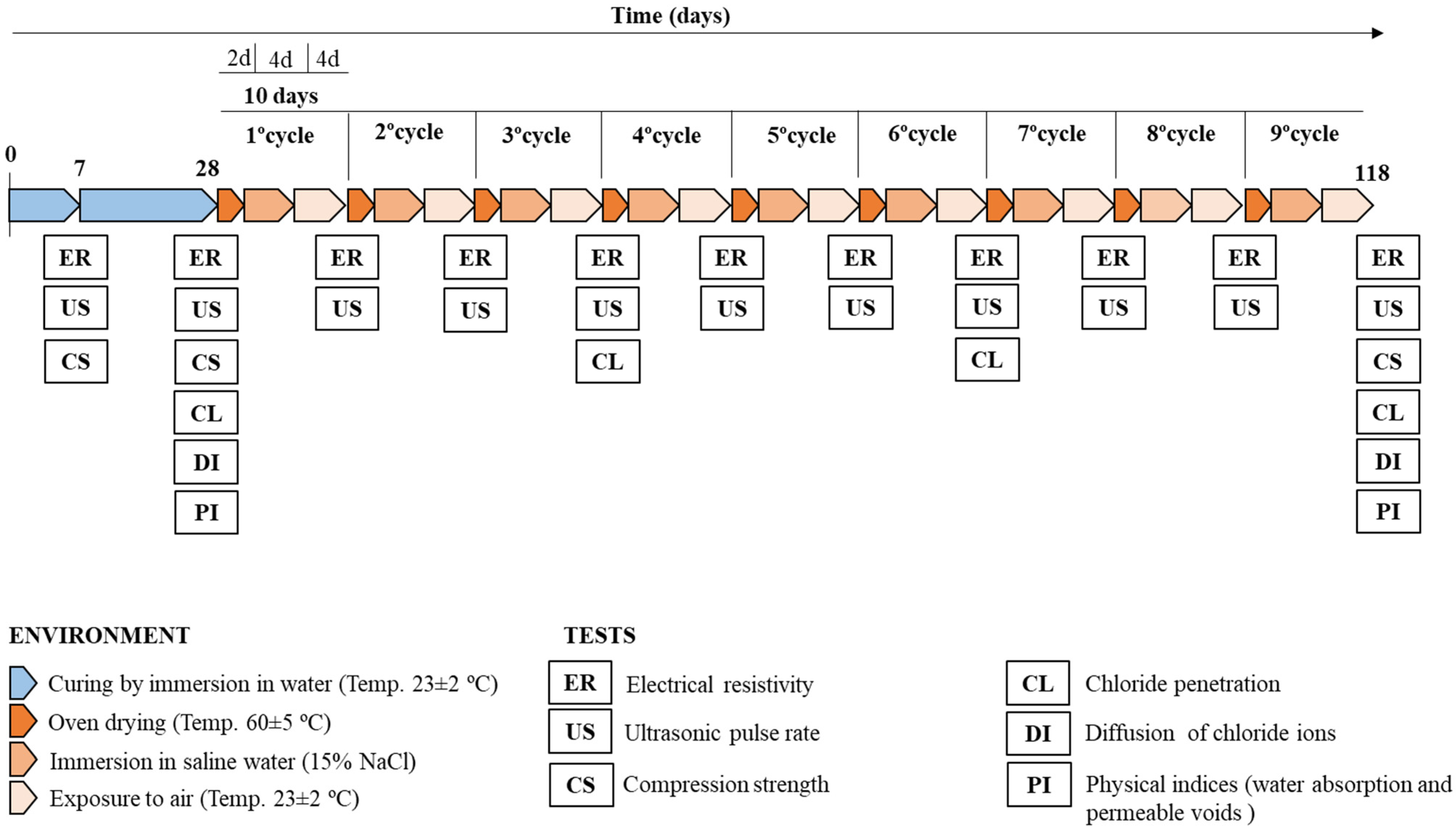
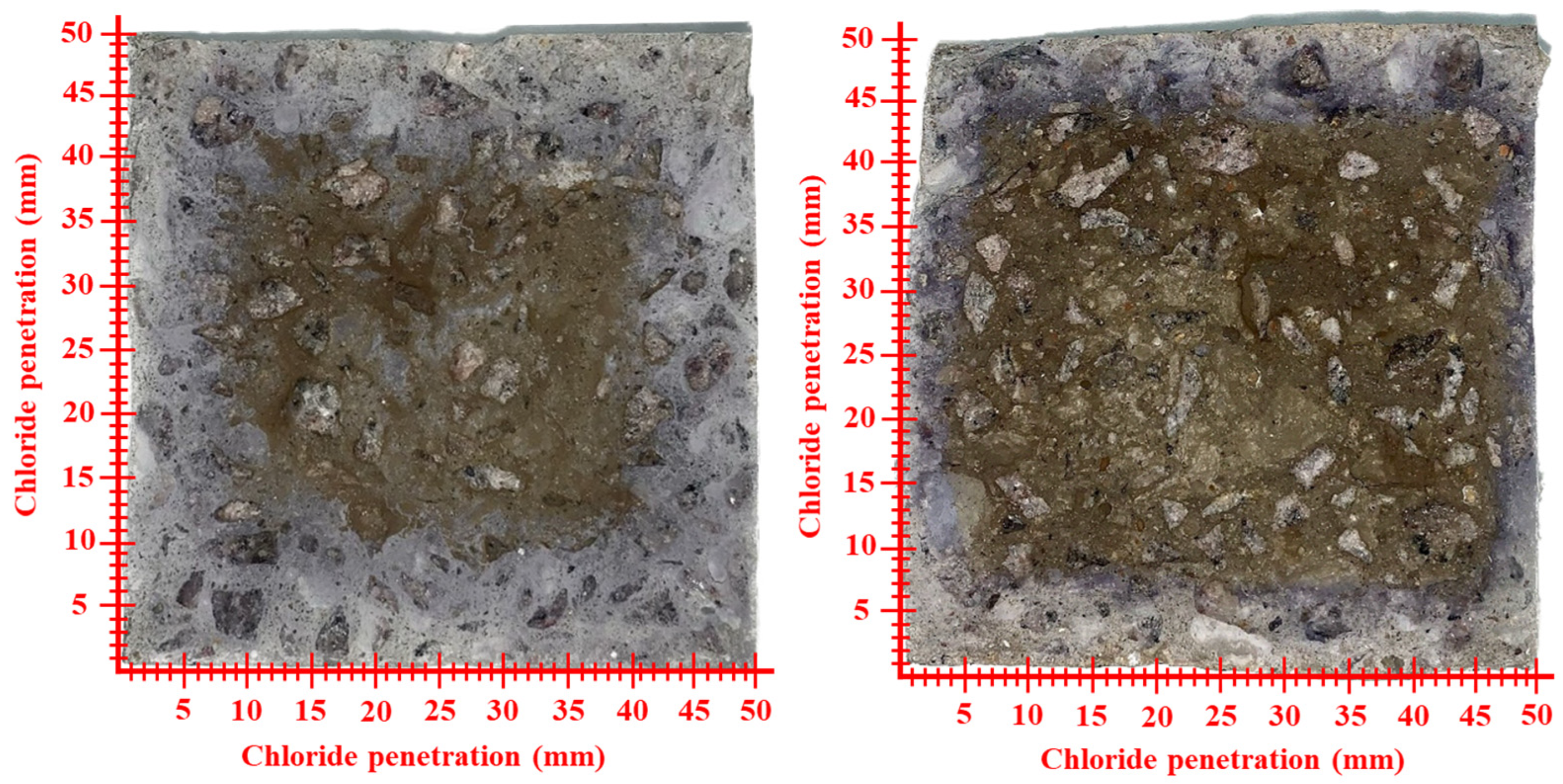
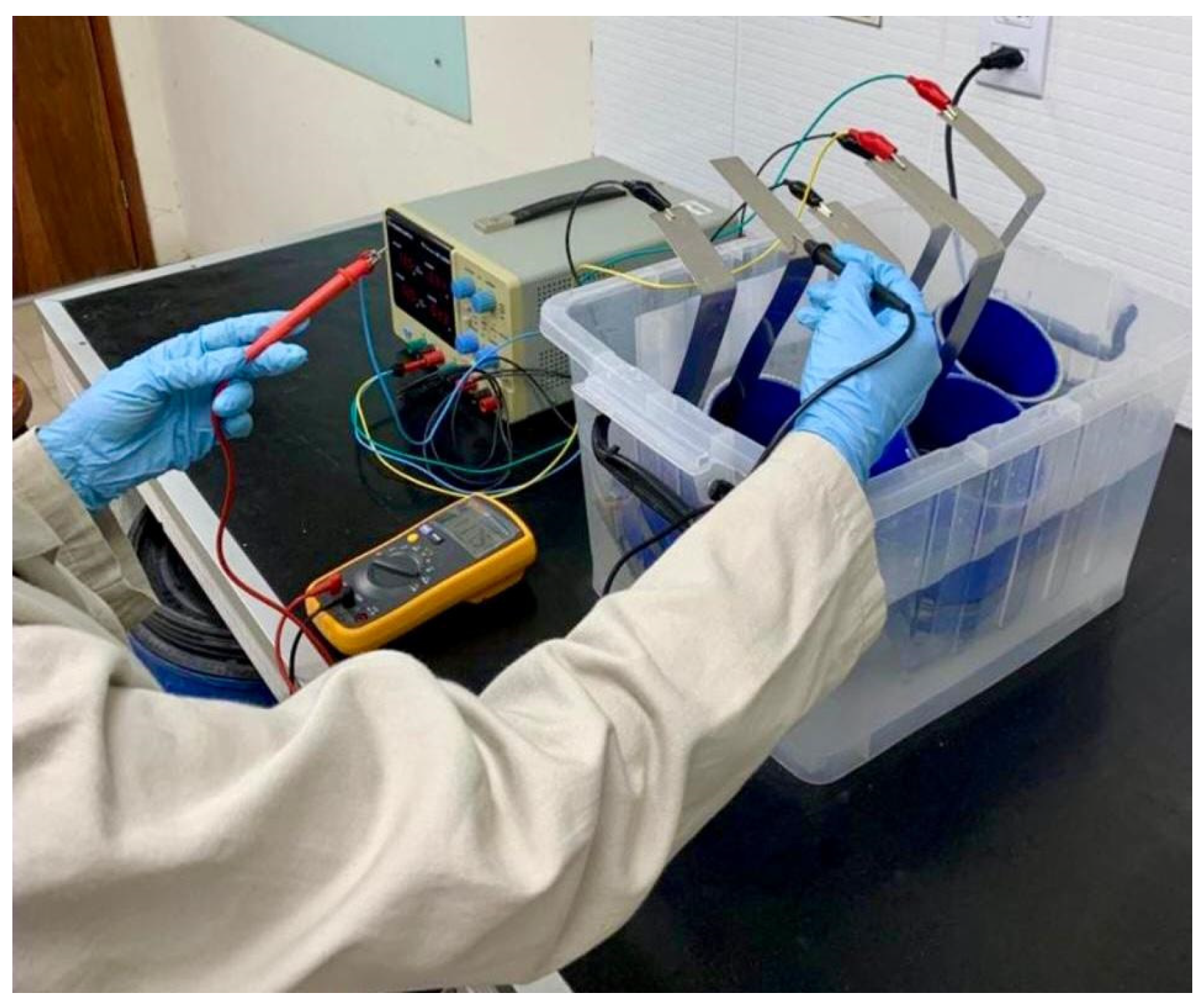

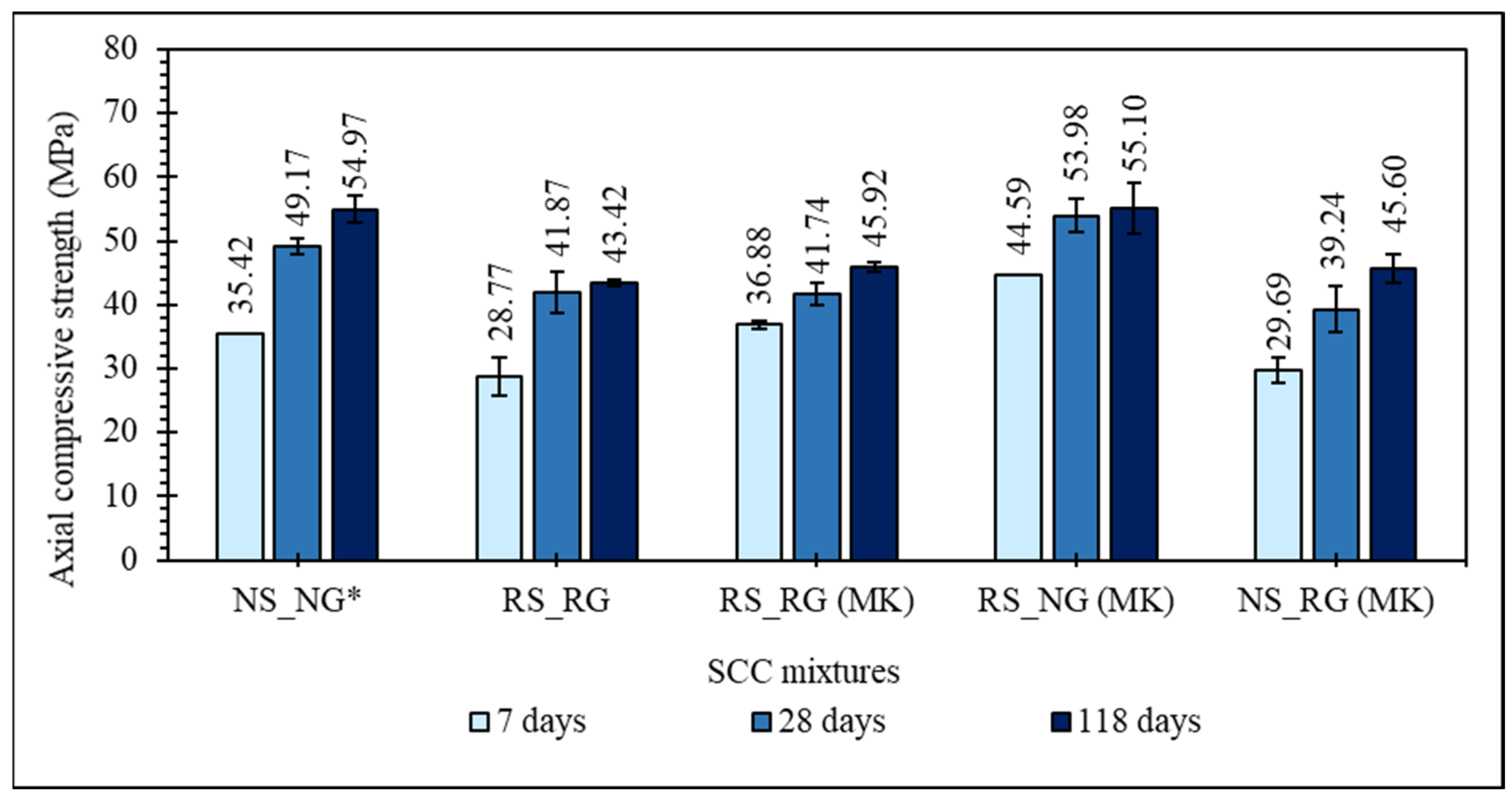
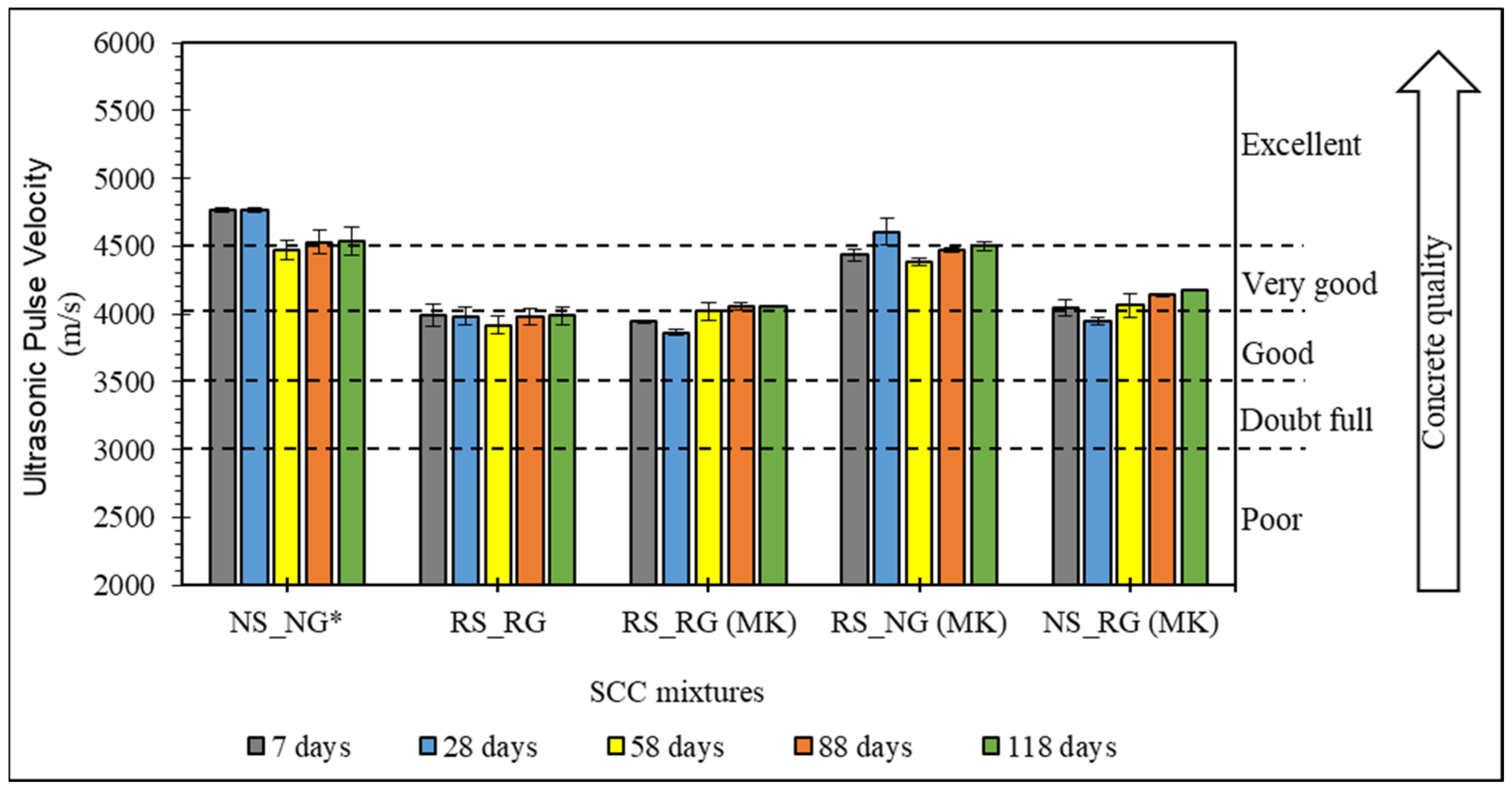
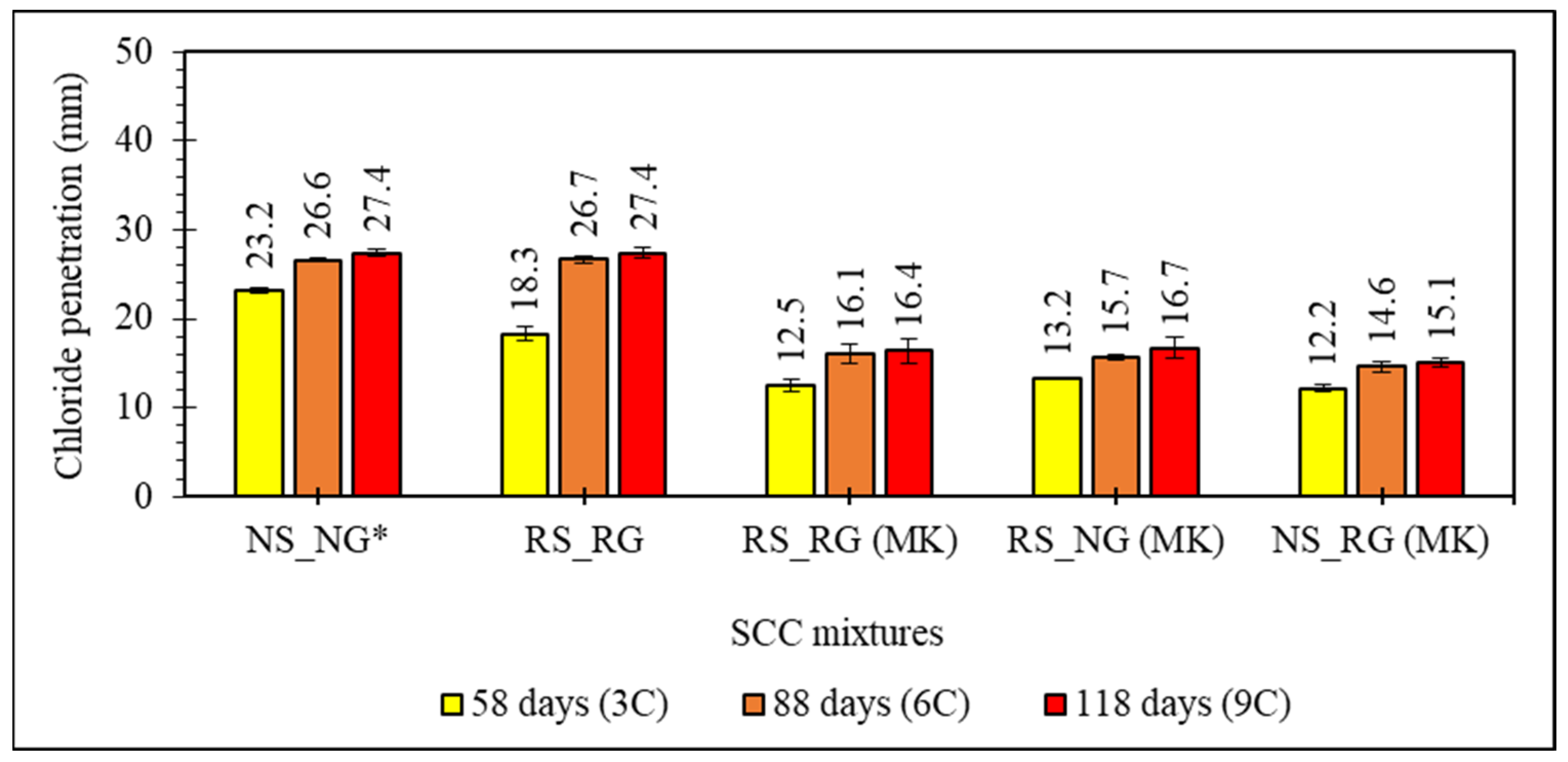
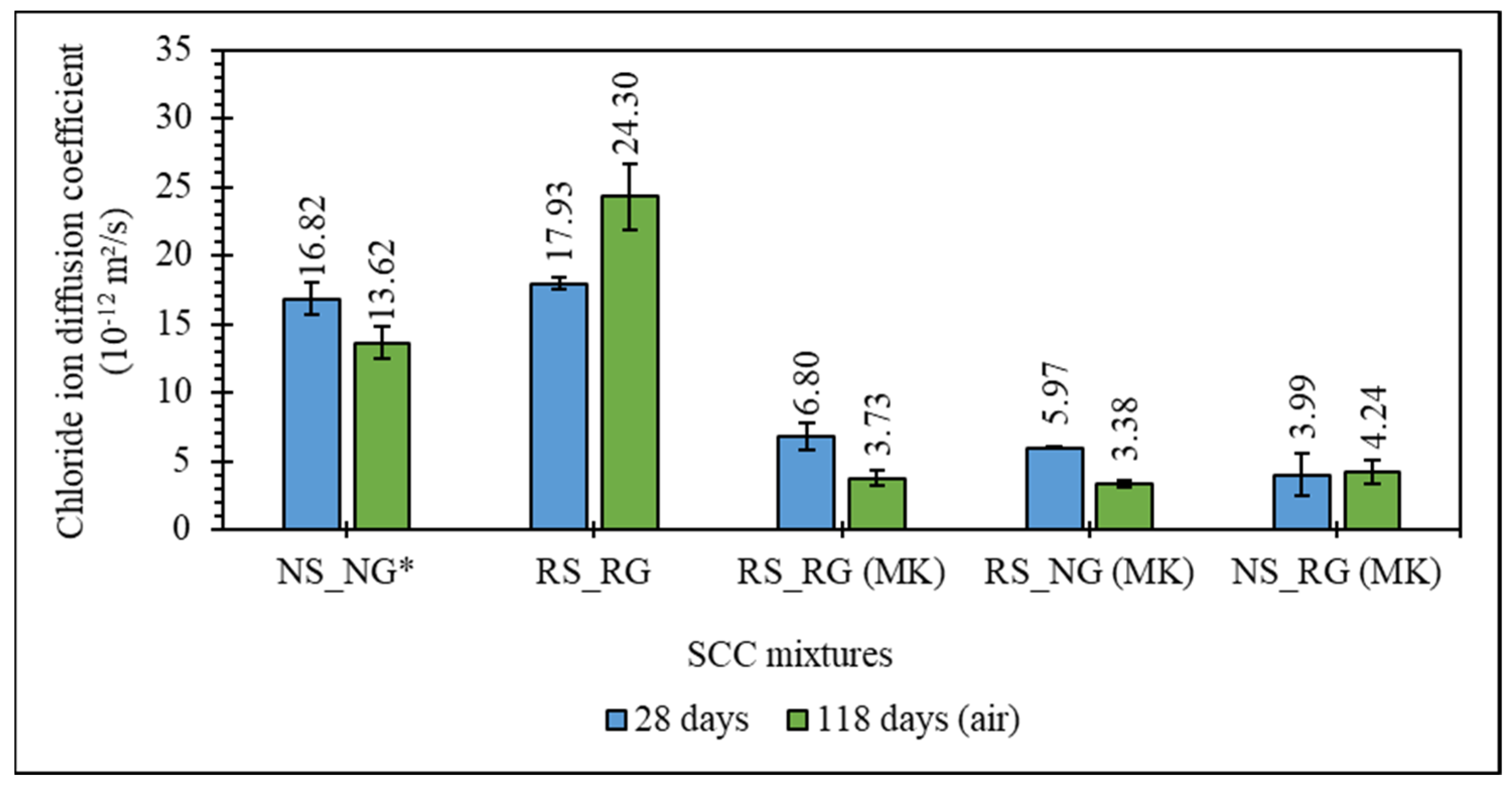
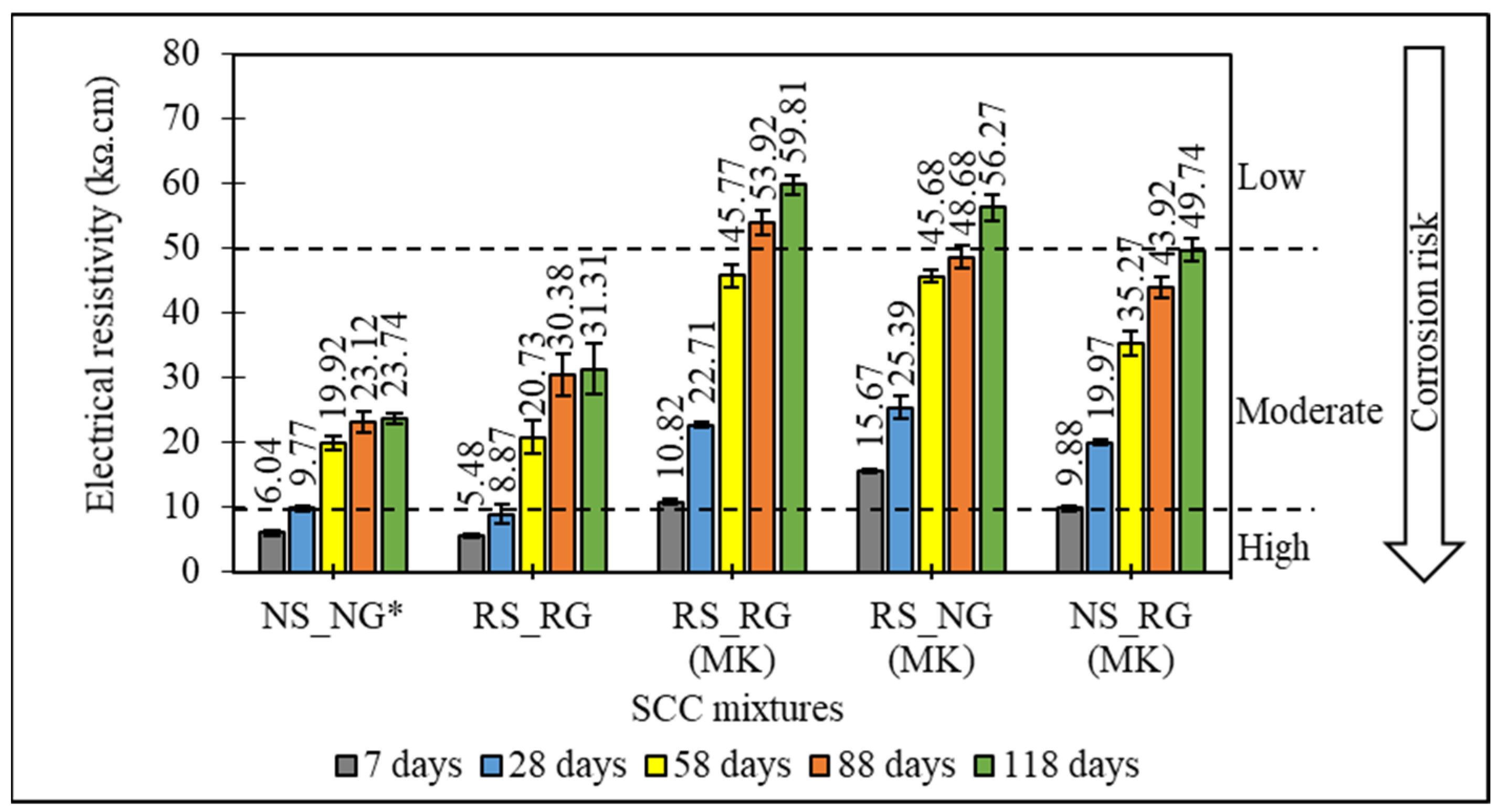
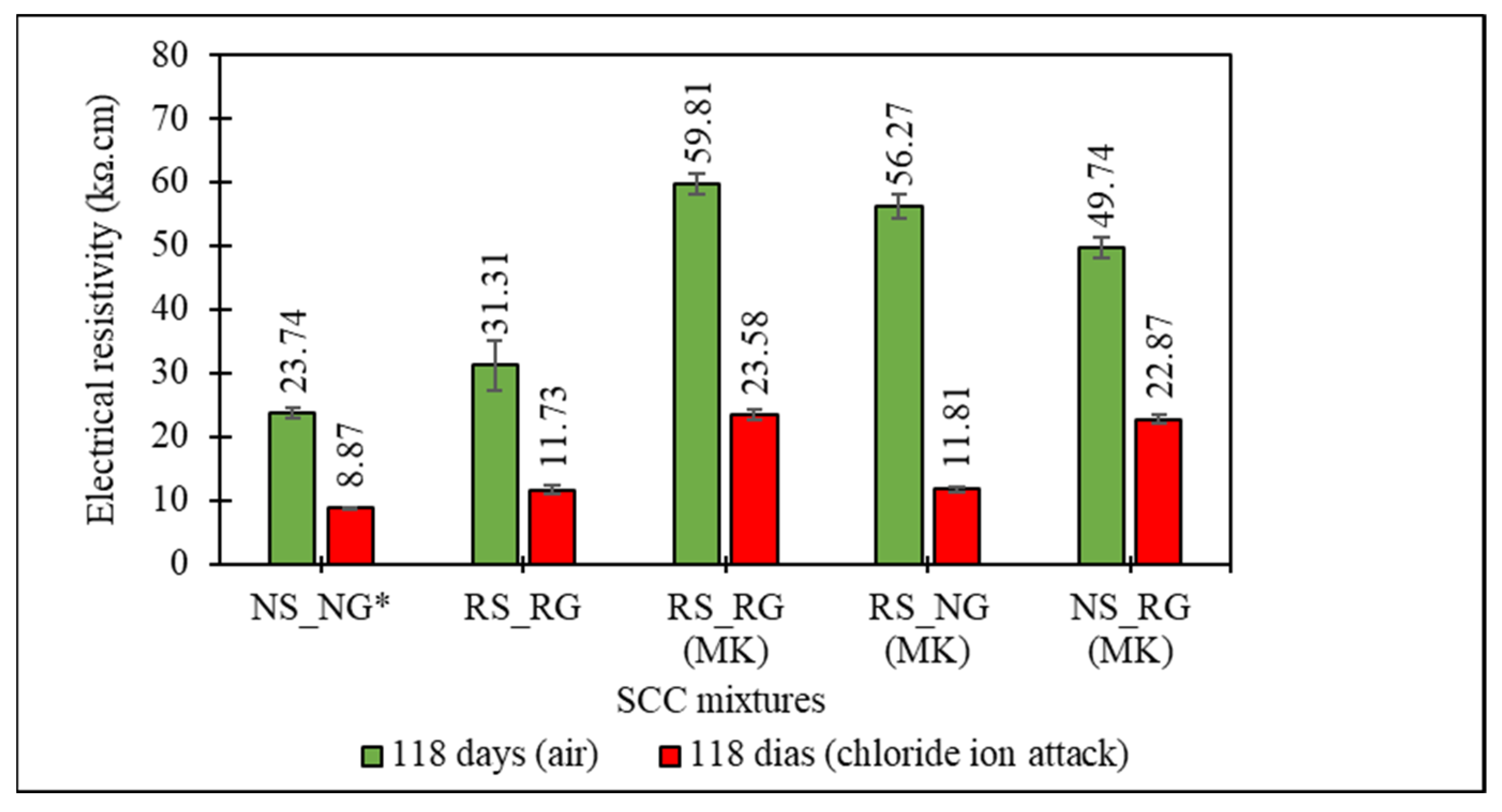
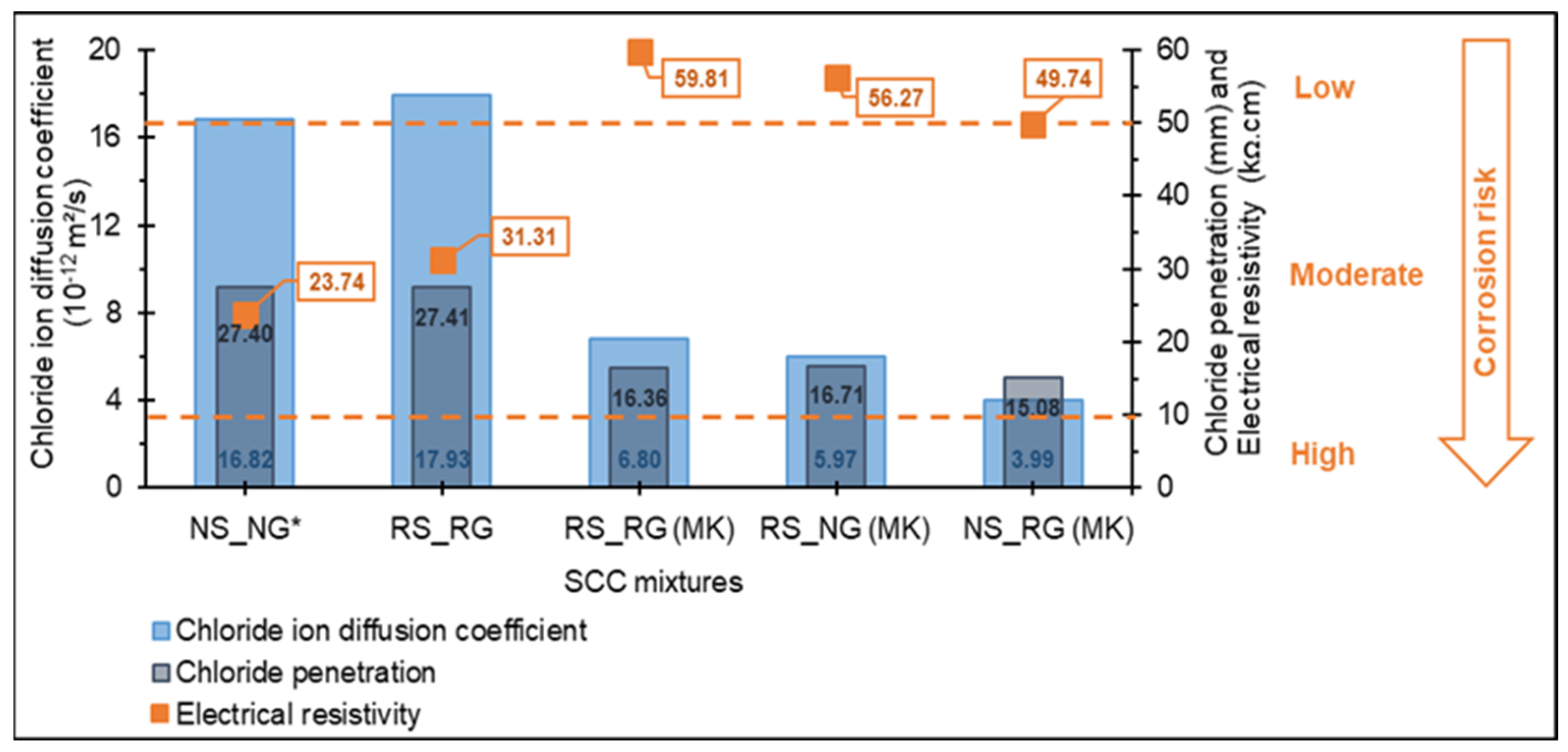
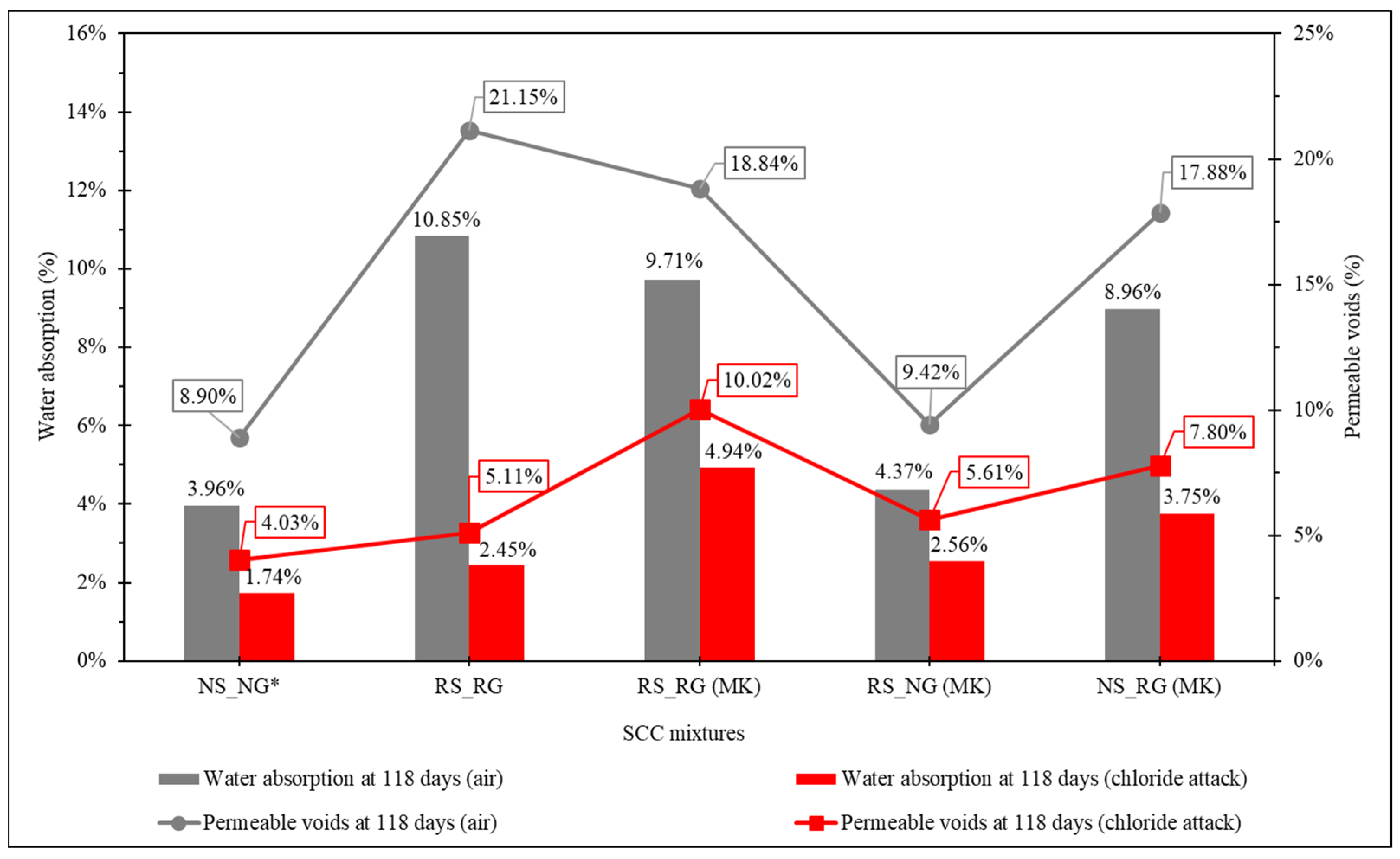
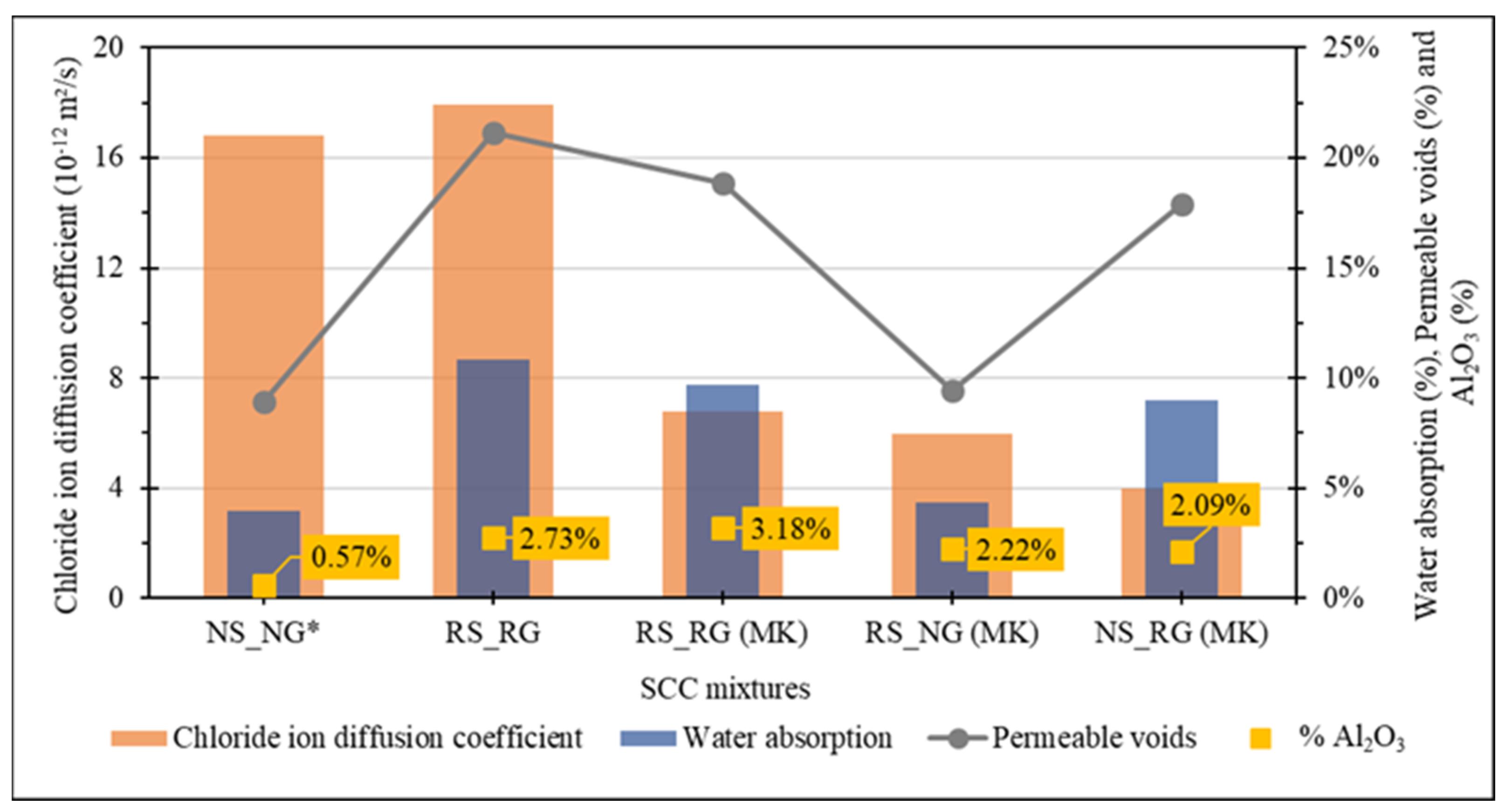
| Ref. | Mixtures | w/b | Slump Flow (mm) | Accordance with EFNARC Guidelines | Reduction in Axial Compressive Strength at 28 Days Compared to the Reference Mixture |
|---|---|---|---|---|---|
| Sasanipour et al. [1] | 100% recycled fine and coarse aggregates | 0.40 | 570 | yes | 27.0% |
| Cuesta et al. [11] | 100% recycled fine and coarse aggregates | 0.53 | 755 | yes | 26.0% |
| Kapoor et al. [13] | 100% recycled coarse aggregate | 0.45 | 700 | yes | 13.4% |
| Bahrami et al. [22] | 100% recycled fine aggregate | 0.41 | 600 | yes | 36.4% |
| 100% recycled coarse aggregate | 0.41 | 587 | yes | 14.6% | |
| Sasanipour et al. [23] | 100% recycled coarse aggregate | 0.40 | 610 | yes | 40.0% |
| Singh et al. [24] | 100% recycled coarse aggregate | 0.45 | 680 | yes | 17.3% |
| Composition | C (%) | MK (%) | RS (%) | RG (%) |
|---|---|---|---|---|
| CaO | 70.10 | 0.12 | 53.6 | 43.9 |
| SiO2 | 13.80 | 55.34 | 29.16 | 32.47 |
| FexOy | 7.60 | 7.14 | 8.86 | 11.28 |
| Al2O3 | 4.00 | 33.55 | 3.74 | 2.97 |
| SO3 | 3.32 | - | - | - |
| K2O | 0.49 | 0.84 | 2.53 | 4.93 |
| TiO2 | 0.27 | 1.32 | 1.76 | 1.66 |
| P2O5 | - | 0.27 | - | 2.62 |
| Others (<1%) | 0.42 | 1.42 | 0.35 | 0.17 |
| Physical Properties | Standard | NS | RS | NG | RG |
|---|---|---|---|---|---|
| Maximum diameter (mm) | NBR NM 248 [30] | 2.40 | 2.40 | 12.50 | 12.50 |
| Fineness modulus | NBR NM 248 [30] | 1.79 | 1.94 | 5.86 | 5.79 |
| Specific gravity (g/cm3) | NBR NM 52 [31] and NBR NM 53 [32] | 2.61 | 2.49 | 2.58 | 2.55 |
| Water absorption (%) | - | - | 14.00 | - | 11.00 |
| Permeable voids (%) | NBR 16,972 [33] | - | 38.55 | - | 42.75 |
| Powder content (%) < 75 µm | NBR NM 46 [34] | - | 14.55 | - | 4.81 |
| Adhered mortar content (%) | - | - | 11.00 | - | 17.00 |
| Materials | EFNARC [35] | Mixtures | |||||
|---|---|---|---|---|---|---|---|
| NS_NG* | RS_RG | RS_RG (MK) | RS_NG (MK) | NS_RG (MK) | |||
| Consumption (kg/m3) | CEM | - | 440.45 | 432.39 | 416.65 | 418.23 | 422.50 |
| MK | - | - | - | 41.66 | 41.82 | 42.25 | |
| NS | - | 792.82 | - | - | - | 760.49 | |
| RS | - | - | 778.30 | 749.96 | 752.82 | - | |
| NG | 750–1000 | 880.90 | - | - | 836.47 | - | |
| RG | 750–1000 | - | 864.77 | 833.29 | - | 844.99 | |
| Water | 150–200 | 213.18 | 209.27 | 221.66 | 222.5 | 224.77 | |
| Additive SP | - | 6.34 | 6.27 | 9.17 | 7.85 | 7.53 | |
| Parameters | % SP to fines | - | 1.44% | 1.45% | 2.00% | 1.71% | 1.62% |
| Water/binder (kg/kg) | - | 0.484 | 0.484 | 0.484 | 0.484 | 0.484 | |
| Binders (kg/m3) | 380–600 | 440.45 | 433.39 | 458.31 | 460.06 | 464.75 | |
| Paste (dm3/m3) | 300–380 | 354.8 | 348.31 | 372.03 | 373.45 | 377.25 | |
| Dry mortar (%) | - | 58.00% | 58.00% | 59.00% | 59.00% | 59.00% | |
| AG (weight % of total aggregates) | 48–55 | 47.40% | 47.40% | 47.40% | 47.40% | 47.40% | |
| Water/binders (m3/m3) | 0.85–1.1 | 1.50 | 1.50 | 1.50 | 1.50 | 1.50 | |
| Al2O3 (%) | ||||
|---|---|---|---|---|
| NS_NG* | RS_RG | RS_RG (MK) | RS_NG (MK) | NS_RG (MK) |
| 0.57 | 2.73 | 3.18 | 2.22 | 2.09 |
| Mixtures | Slump Flow | J-Ring | V-Funnel | L Box | Classification | ||||
|---|---|---|---|---|---|---|---|---|---|
| T500 (s) | Slump Flow (mm) | T500 (s) | J-Ring (mm) | Time (s) | H2/H1 | Slump Flow | Viscosity | Passing Ability | |
| NS_NG* | 2.03 | 773.33 | 3.50 | 763.33 | 6.00 | 0.90 | SF3 | VS1/VF1 | PL2/PJ1 |
| RS_RG | 2.28 | 730.00 | 2.92 | 710.00 | 7.50 | 0.83 | SF2 | VS1/VF1 | PL2/PJ1 |
| RS_RG (MK) | 2.10 | 763.33 | 4.53 | 740.00 | 8.22 | 0.83 | SF3 | VS1/VF1 | PL2/PJ1 |
| RS_NG (MK) | 1.97 | 716.67 | 3.15 | 716.67 | 5.50 | 0.77 | SF2 | VS1/VF1 | PL2/PJ1 |
| NS_RG (MK) | 1.60 | 740.00 | 2.87 | 740.00 | 6.63 | 0.81 | SF2 | VS1/VF1 | PL2/PJ1 |
Disclaimer/Publisher’s Note: The statements, opinions and data contained in all publications are solely those of the individual author(s) and contributor(s) and not of MDPI and/or the editor(s). MDPI and/or the editor(s) disclaim responsibility for any injury to people or property resulting from any ideas, methods, instructions or products referred to in the content. |
© 2024 by the authors. Licensee MDPI, Basel, Switzerland. This article is an open access article distributed under the terms and conditions of the Creative Commons Attribution (CC BY) license (https://creativecommons.org/licenses/by/4.0/).
Share and Cite
Peixoto, L.K.S.; Anjos, M.A.S.d.; Farias, E.C.d.; Branco, F.G. Evaluation of Chloride Ion Attack in Self-Compacting Concrete Using Recycled Construction and Demolition Waste Aggregates. Buildings 2024, 14, 319. https://doi.org/10.3390/buildings14020319
Peixoto LKS, Anjos MASd, Farias ECd, Branco FG. Evaluation of Chloride Ion Attack in Self-Compacting Concrete Using Recycled Construction and Demolition Waste Aggregates. Buildings. 2024; 14(2):319. https://doi.org/10.3390/buildings14020319
Chicago/Turabian StylePeixoto, Lorena K. S., Marcos A. S. dos Anjos, Evilane C. de Farias, and Fernando G. Branco. 2024. "Evaluation of Chloride Ion Attack in Self-Compacting Concrete Using Recycled Construction and Demolition Waste Aggregates" Buildings 14, no. 2: 319. https://doi.org/10.3390/buildings14020319







